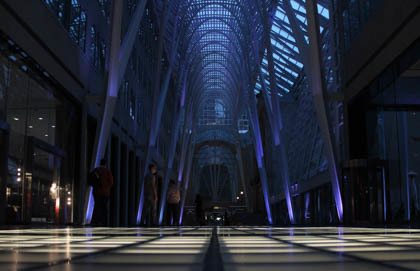Canada's newest Roman Catholic Cathedral, which officially opened in Saskatoon this spring, sprawls like a giant wimple discarded on a suburban prairie site. The Cathedral of the Holy Family was built in the extreme northeast end of the city to serve the fastest growing parish in the diocese. It stands 10 kilometres from the old St. Paul's Cathedral, which was built downtown on the banks of the South Saskatchewan River in 1911 and which retains its status as a co-cathedral.
The new $32 million complex, under a 54 metre Cross, was designed by local architect Obert Friggstad, who, working with a parish Worship and Liturgy Committee, envisioned a church in a different way. It is one of the largest religious buildings to be erected in Canada in half a century, yet no national architectural design competition was held for it.
"There was a selection process. Architects did compete for the job, but not by design," explains Friggstad, who came out of retirement to work on the project. Friggstad grew up in Frontier, Sask., and obtained his degree in architecture from the University of Manitoba in 1970. He had previously worked for the diocese designing the contemporary Holy Spirit Church in east end Saskatoon and then drawing up the plans for the renovation and expan-sion of St. Anne's.
A building committee added to the complexity of designing the cathedral, says Friggstad and, as a result, the initial scope of the project changed. "Because it was to be more than just another parish church, the committee added a convention compo-nent and a smaller chapel," he explains.
In addition to the octagonal worship space with its fan-shaped seating for 2,000, the project ended up as a 19,800-square-metre complex that houses the Catholic Pastoral Centre, a banquet hall, meeting rooms, the diocesan archives, a rectory and a bishop's office.
There was a nod to Saskatchewan's Aboriginal community in the design and a clear distinction has been made between the liturgical and devotional aspects of the building. For example, the Stations of the Cross and a tabernacle for the Blessed Sacra-ment are conspicuously absent from the sanctuary. The tabernacle is located in a small room all by itself between the main worship hall and the adjacent Queen of Peace chapel, which seats 75. The Stations of the Cross, carved from white birch by William Judt, are in the chapel. There are no confessionals but a chapel of reconciliation, which resembles the waiting room in a psychiatrist's office.
The Cathedral has more in common with big box stores and strip malls in the area. "It is a little bit different," agrees facilities manager Jim Nakoneshny, who served as building committee chairman.
"It was designed to be a community facility, open, ecumenical and welcoming. We intentionally wanted it low and wide; it had to have a human scale."
Friggstad's original design was modified by the firm of Friggstad Downing Henry Architects (now Henry Downing Howlett) and built by Graham Construction. Le Corbusier, who knew something about ecclesiastical architecture, suggested a cathedral should be a place of silence, of prayer, of peace, of spiritual joy, all inspired by a sense of what is sacred.
There are some serious problems inside. The attempt to make something timeless and spiritual out of what is essentially a nondescript office block has made navigating the building confusing. Its civic status is obvious the moment you step into the ambulatory, which blends into a parish hall to the right, meeting rooms farther down the corridor, and a bank of offices to the left. The welcoming fireplace and a comfortable seating area with leather chairs are more in keeping with a coffee shop than a church. The worship area with its carved hardwood pews is little more than a vast auditorium, com-fortable and inoffensive. There are no great doors to welcome you, nothing that defines the worship space. A ceremonial walkway made of Jerusalem sandstone connects the granite baptismal font in the narthex to the bishop's throne, or cathedra, which is located dead centre in the chancel.
"Structurally, it was easier to break the worship space down into eight straight lines," explains Friggstad. As a result, the sight lines are perfect; no one is more than 21 metres from the sanctuary. However, the bishop's chair, not the altar, is the focal point. The altar—which should be the most important liturgical element—is barely visible. It is so small that it looks like a side table to the throne. The problem could be resolved by installing a soaring altar screen behind it or a distinctive baldachin above it. The Cross on the back wall is lost in the space around it. Similarly, you have to look twice before you notice the processional Cross placed next to the ambo.
The most exceptional feature of the church is the heavenly light that filters through the monumental stained glass windows. Designed by Sarah Hall Studio in Toronto, the three "Lux Gloria" windows have solar cells embedded in the art glass. Five mismatched smaller windows in the sanctuary are based on the themes of creation, covenant, incarnation, proclamation and revelation.
A cathedral should not only be an expression of the spiritual strength of a community but an uplifting architectural symbol as well. It should be a building whose design embodies our most profound beliefs, and offers believer and non-believer alike some insight into religious doctrine, history, geography and technology.
There is nothing wrong with the overall contemporary design of the Holy Family Cathedral, but this building, as modern and as technically sophisticated as it is, is devoid of spiritual dimension.






